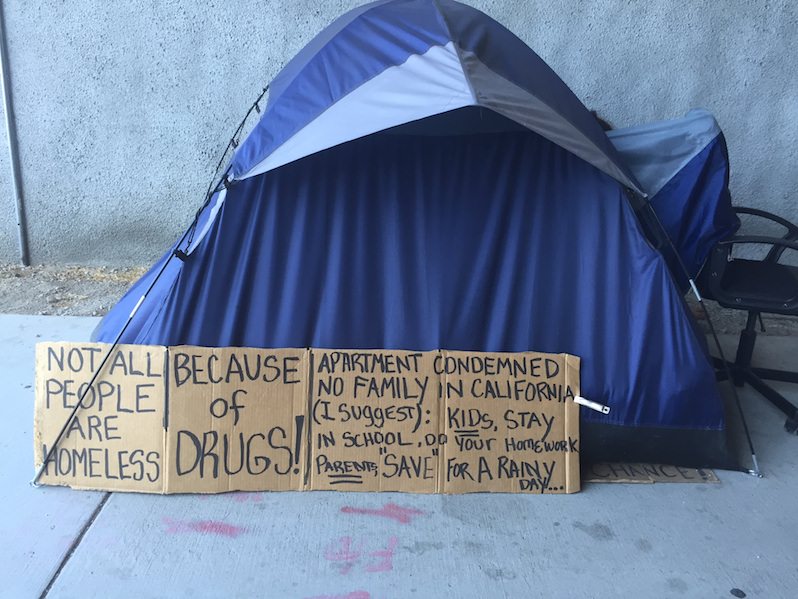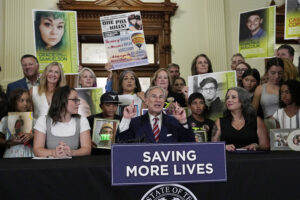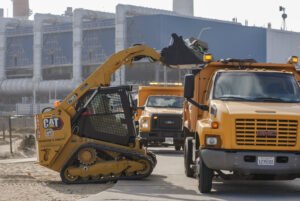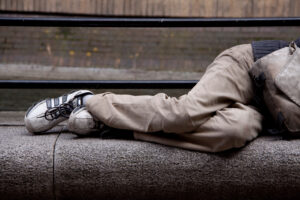Why Ending Homelessness Is Political Poison
While the popular idea is that the homeless are addicted or mentally ill, experts say a more common story goes like this: A single parent loses a job and ends up on the streets with his or her children. Meanwhile, officials say there is no political upside to solving the problem. Bill Boyarsky
Bill Boyarsky
2016 Southern California Journalism Award: First Place, Activism Journalism, All Platforms
This is the first installment in a three-part series that Truthdig columnist Bill Boyarsky is writing on homelessness.
READ: Part 2: Go Directly to Jail: Punishing the Homeless for Being Homeless Part 3: Helping the Homeless in the Face of GOP’s Brutal Funding Cuts
On a hot, sultry day in July, I walked through Los Angeles’ Skid Row, the largest and most infamous of the city’s numerous homeless encampments. It is a little-visited part of a city better known for its celebrities and showy materialism — a city where the very rich build mansions with a dozen or more bedrooms while the poorest of the poor live on sidewalks, under freeways or in parks.
Buildings trapped the street’s heat. Some residents sat in tents or under tarps in stifling conditions. Others were standing or sitting on the sidewalk, with their backs against the buildings. So packed were the sidewalks with people, tents and possessions that sometimes I had to walk in the street. I was so intent on observing the scene that at one point I stumbled and almost fell. A homeless man asked if I was OK. I assured him I was. He patted me on the back and told me to be careful.
Skid Row is a very “California” scene—one from the underside of the mythic state of sunshine and dreams of wealth. The down and out, as well as many other types of outsiders, have always had a rough time in this lush land. Decades ago, immigrants who had moved westward—the Okies, Arkies and others—were pushed into farm labor camps or were blocked at the California border. Japanese-Americans were imprisoned in camps during World War II. An alien land law banned Asians from owning farmland, and in the state’s early days, invading Anglos and their heirs persecuted Mexicans and Native Americans. Remnants of that attitude linger.
What those oppressed groups all had in common was being treated as an under class by the governing majority. The people in the homeless encampments have now inherited this unfortunate status.
Today, the problem of homelessness is immense. The National Center on Homelessness & Poverty estimates that in the United States, 2.5 million to 3.5 million people sleep in shelters, in temporary transitional housing, on sidewalks, in parks, underneath freeways and on buses and trains. An additional 7.4 million, the center says, are living with relatives or friends after having lost their own homes. These figures “are far from exact,” because they come from several different sources, each with their own way of counting the homeless. But they reflect the depth of the problem.
There are 25,686 homeless in the city of Los Angeles, the largest city in Los Angeles County, where the homeless number 44,359, according to the Los Angeles Homeless Services Authority. There is definitely a racial component. African-Americans are the hardest-hit, composing 47 percent of the homeless population, although only about 9 percent of Los Angeles residents are black.
Mollie Lowery, a consultant at Housing Works — which finds housing and care for the homeless — has worked with the homeless on Skid Row for decades. She told me that Los Angeles is “a city of abundance, but the abundance is not shared.” Steve Clare, the executive director of Venice Community Housing Corp., which also helps people find housing, shared a similar view. “Los Angeles is known as the meanest big city in America,” he said.
While the popular idea is that most of the homeless are addicted or mentally ill, experts say the reality is much more complicated. A more common story goes like this: A single parent loses a job, can’t pay the rent and moves in with friends or family. Next, the streets.
“We have single mothers with limited job skills, couldn’t pay their rent, were evicted,” Rabbi Marvin Gross told me. “Most of the people we work with are born into poverty.”
Gross, who leads Union Station Homeless Services — an organization that serves a wide area of Los Angeles County reaching into the San Gabriel Valley suburbs — was referring to victims of an economy that is brutal to the poor. When moving in with friends and relatives doesn’t work out, he said, parents and kids may end up living in their cars, with Mom or Dad always on the lookout for welfare workers who might take the children away. From there, the next move is downward to the streets and the parks, a process that would drive anyone to the edge of sanity.
Homelessness has always been with us. The hobo is a familiar figure in American history and culture, and so is the term “skid row,” which came into common use in the U.S. in the 19th century, first as a timber-industry reference. In a social context, it took on greater resonance during the Great Depression.
In 2007, the Great Recession put many women and men on the streets as it wiped out jobs and savings. Meanwhile, the Republican-controlled Congress, particularly the House, cruelly slashed federal funds for the subsidies that help pay for housing for the poor.
“The House’s … proposal severely limits our ability to end homelessness, invest in distressed communities, and provide housing support for very low income households,” Secretary Julián Castro of the Department of Housing and Urban Development said in a statement last May. “In a nation founded on the principle of equality of opportunity, it’s unacceptable to support anything less than an expansion of opportunity for all.”
I have visited Los Angeles’ Skid Row for years while reporting for the Los Angeles Times and now for Truthdig, but I have never seen it so bad. It is now smaller and much more crowded than it once was. Gentrification has come to once sleazy parts of downtown, squeezing Skid Row into fewer blocks. Old hotels, which once offered low-cost housing, and office buildings have become expensive lofts, and tattered saloons have become fashionable purveyors of craft beer.
I finally arrived at my destination, the headquarters of Los Angeles Community Action Network, which organizes the impoverished residents of Skid Row and South L.A. to fight for decent housing. It also vigorously opposes punitive city laws aimed at criminalizing homelessness. I gratefully accepted a bottle of water and sat down with Becky Dennison, the co-director. We talked about Mayor Eric Garcetti and City Attorney Michael Feuer, two liberals involved in the controversy over the new laws, which Feuer’s office wrote.
After the election, Dennison said, Feuer called a meeting in his office with representatives of the police department and businesses in the Skid Row area.
“He did not invite the grass-roots groups,” she remembered. “This was the first couple of months after he took office.”
Despite not being invited, Carol Sobel, a civil rights lawyer representing the homeless, was there and insisted that homeless advocates go in.
“They were not pleased to see us,” Dennison added.
Dennison and the others pressed for more housing and a relaxation of tough policing. “Since 2006, more than 15,000 high-end loft units have been built in Downtown LA,” she said, “while only about 900 affordable homes were created.”
She said the police and the business people favored tough enforcement of the laws. “They said the homeless were creating crime.” Since then, she continued, enforcement has increased. “We have not [previously] seen this level of enforcement.”
At the center of the controversy are three ordinances. One would ban the homeless from camping in parks or leaving their possessions in them. Another would make it a violation of the law for the homeless to put up tents or tarpaulins on sidewalks, in alleys or in any other public place. A third measure, awaiting approval, bans the homeless from living in motor vehicles.
These laws are as punitive as any law in the country, civil liberties lawyers say, criminalizing behavior that the homeless cannot avoid because they have no other place to go.
I wanted to know how liberal public officials in a reliably liberal city could support such laws.
I asked the mayor. He is trying to satisfy property owners, business people and other residents who want the homeless off the streets, but he doesn’t want to be inhumane to the downtrodden. It’s the dilemma of liberals in city halls from here to New York.
So far, he has halted enforcement of the laws until the City Council removes some of their harsher penalty provisions. A City Council committee voted 3-2 to do this recently, but it’s not known whether the full council will support the action.
Garcetti, a Democrat who represented the Hollywood area on the City Council for 12 years, was elected mayor in 2013. Caution marked his tenure on the council — where he rose to president — just as it has marked his time in the mayor’s office. When police shootings, including those of two African-American men, one homeless, provoked demonstrations, Garcetti was reluctant to speak out on an issue that pitted the police against the black community, avoiding the public peacemaker’s role that was badly needed. Perhaps his caution stems from a belief that if he can survive City Hall, the chance of higher office, and possibly a race for the Senate, awaits.
“I think we should set the goal of ending homelessness,” he told me. “A lot of people say don’t talk about homelessness and don’t talk about ending homelessness because there is no political upside, the problem is intractable. … But I have worked on this issue ever since I was 14 or 15. When I was in junior high school, I used to come down and volunteer on Skid Row.”
It would be a surprise if Garcetti succeeded, although I hope he does. The issue, as he suggested, is considered political poison. If a politician does something for the homeless, he or she will be the target of rage from businesses and entire neighborhoods.
Homelessness doesn’t rate a mention on the presidential campaign trail. For President Barack Obama, it’s an afterthought — far overshadowed by his determination to get the Iran deal through. Republican reductions in funding for housing aid for the homeless have occurred without a protest except from homeless-advocacy organizations. The subject is ignored or followed sporadically in the national media outside of policy-oriented journals. Washington is happy to leave it in the hands of local politicians, cops and reporters who cover city halls and city streets.
Out of sight and out of mind is the American treatment of the homeless. In Los Angeles, out of sight means imprisonment in a house of horrors known as county jail.
Your support is crucial…With an uncertain future and a new administration casting doubt on press freedoms, the danger is clear: The truth is at risk.
Now is the time to give. Your tax-deductible support allows us to dig deeper, delivering fearless investigative reporting and analysis that exposes what’s really happening — without compromise.
Stand with our courageous journalists. Donate today to protect a free press, uphold democracy and unearth untold stories.






You need to be a supporter to comment.
There are currently no responses to this article.
Be the first to respond.